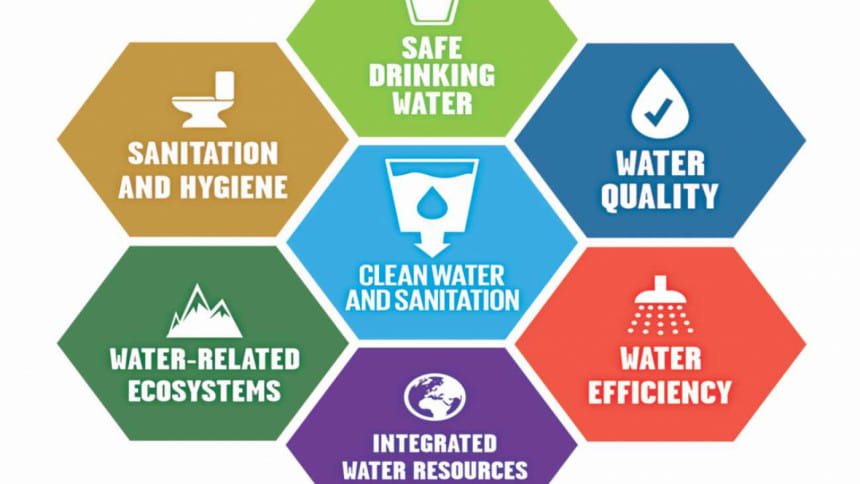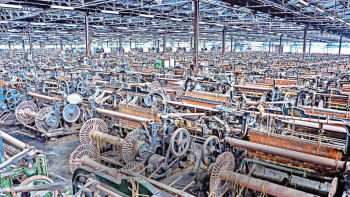Safe water for everyone?

In 2015, the global community adopted 17 Global Goals, also called the Sustainable Development Goals (SDGs), aimed at ending extreme poverty, fighting inequality and injustice, and combating climate change. The Global Goals signalled a shift in thinking, from linear modular to acknowledging the complexities of the current state of global affairs, and the role every country has to play in them. One of the key features of the goals is that they present a universal agenda, where every country has a responsibility to adopt contextualised targets based on its current situation, in order to ensure the goals for all its citizens. This is no longer the 'business as usual' of development, where developing countries are running a race to catch up with the standards of their wealthier counterparts – truly abiding by the goals requires that we reach everyone, everywhere by 2030.
Equally, for the developing countries that have performed well against the Millennium Development Goals (MDGs)—Bangladesh amongst them—this means that the journey is far from over. Bangladesh did particularly well both in increasing access to improved water (currently at 87 percent adjusting for arsenic contamination) and sanitation (with open defecation currently at 1 percent only), and has been widely lauded for its success in doing so despite limited resources and numerous socioeconomic challenges. The appointment of the Prime Minister to the UN Global Panel on Water is testament to the country's remarkable success in innovating effective, appropriate WASH (water, sanitation and hygiene) solutions that have reached millions in a relatively short span of time. While this means that we start from a strong baseline for Global Goal 6—ensuring availability and sustainable management of water and sanitation for all—there is still a long way to go once we look beyond the primary question of access; moving up the ladder to issues of quality, protection and sustainability.
This shift involves a host of issues that we are only beginning to grapple with – rising inequality, climate change, faecal sludge management – the list goes on. This newspaper has published on many of these topics before, and continues to be a voice for those championing Goal 6 in Bangladesh. This article breaks down some of the headline issues of Goal 6, taking a closer look at the indicators, particularly 6.1 and 6.3, and going into the complexities and possibilities of delving into the specifics.
The reason behind doing so is that in the case of water, sanitation and hygiene, many of our past victories have come from small, doable actions as much as they have from large scale interventions. The nature of WASH—completely integrated into people's lives, and manifesting itself moment-by-moment—is such that national success relies as much on the micro level of individual and community actions as it does on bigger questions of political will and development programmes.
One of the biggest challenges we face in attaining Goal 6 would appear, at first glance, to be one of the smallest. The issue of water quality is built into 6.1 in the term 'safe' water, and is the subject of indicator 6.3. However, it is one that often automatically assumes second place to the difficulties of extending water and sanitation coverage in Bangladesh's challenging economic and environmental context. Add in the full menu of Goal 6—sanitation, hygiene, water scarcity, ecosystems, trans-boundary water management and integrated water resources management—and water quality can seem less demanding in comparison.
However, the crisis of water quality, particularly pathogen and arsenic contamination in the particular case of Bangladesh, is at the centre of one of our biggest challenges in WASH; a problem that will continue to affect millions—particularly children—through waterborne diseases, lost school days, and poor nutrition, unless it is seen for the major development challenge that it is. The last Multiple Indicator Cluster Survey (MICS) conducted by UNICEF and Bangladesh Bureau of Statistics revealed the deplorable state of water quality in the country. The survey found that 12.5 percent of households are still drinking water with arsenic at over the Bangladesh standard of 50 ppb, and 25.5 percent at over the WHO standard of 10 ppb. Furthermore, 41.7 percent of the population had source water with detectable levels E. coli. This already afigure rose to 61.7 percent when samples from households were tested – a 20 percentage point increase coming from the time between the point of collection and use. The proportion of the population having water containing very high levels of contamination (>100 cfu/100 ml) was 7.4 percent at the source and 13.5 percent at the household level, reflecting a similar pattern of high contamination levels made worse in the journey from source to home.
Another unusual aspect of this phenomenon is that the rate of levels of contamination is over three times higher for urban settlements (18 percent of households) compared to rural (4.7 percent), meaning that nearly one in five urban households are at serious risk of consuming highly contaminated water. These numbers indicate that while we might be doing well on coverage, we are far from the "safe and affordable drinking water for all" of Goal 6.
While arsenic is a naturally occurring phenomenon, a question of interest and great relevance is where such high levels of pathogenic contamination arise from. One of the most frequently cited reasons is seepage from pit latrines leading to faecal contamination of groundwater aquifers. This has led to recommendations to maintain a 'safe' distance between water sources and latrines – one that is difficult to adhere to given the average size of a rural landholding in Bangladesh, and the ubiquity of the pit latrine as the sanitation option. Moreover, this is only part of the story. A recent study by a team at icddr,b establishes the role of other channels that can lead to faecal contamination of water – including contamination of the well-pump system and the post-collection handling and storage also identified in MICS. The first of these is rarely discussed in current WASH programmes, but is critically important – the use of dirt or contaminated materials during construction can contaminate a water source, and parts of the tubewell can act as bacteria reservoirs.
However, this still leaves unanswered questions, especially with regard to the trends seen in MICS. While there has been some research on rural water contamination, it is not yet clear why rate of contamination levels in urban areas are so high. Although we can surmise that this is due to the overcrowded, unhygienic conditions of low income settlements, as well as leakages in the piped water systems, there is a pressing need for rigorous research that can establish the pathways of contamination and lead towards knowledge-based solutions.
In the meantime, there is an ongoing crisis that has to be dealt with urgently. One of the most pertinent examples of an effective, low cost intervention at the level of household water quality is the Water Safety Plan (WSP). The WSP lays out a comprehensive risk assessment and risk management approach that covers all steps in water supply from the catchment to the point of consumption. In Bangladesh's context, this approach translates to simple, doable actions such as covering the collection vessel; storage in a clean, covered vessel; and serving in a clean glass. Where we now have to work is getting this message to every family.
Another possible remedial suggestion in the short term is treatment of water at the household level. MICS 2012-13 revealed that the vast majority of households (92 percent) do not undertake any kind of treatment. While household water treatment is yet to become a common practice, it is increasingly entering popular consciousness through another channel – the advertisement of commercial household water filters in media. While these highly priced and technologically advanced units are becoming increasingly favoured, especially amongst urban households suspicious of supply water, the sales pitch for these filters often rely on dismissing other forms of treatment, such as boiling, as ineffective. This undermines cost-effective and available treatment options for an "ideal" product that is beyond the reach of the majority of the country's population. Instead, raising awareness of our citizens regarding the dangers of contamination and affordable treatment at home can mitigate the problem to an extent, as we work towards public water supply that is safe from source to home.
This final, desired outcome – safe piped water at the household level – is where the vision of Goal 6 can inspire and guide us. Achieving Goal 6 requires that we work with integrated plans that can address immediate problems, while also leading towards a transformation of the country's current water and sanitation landscape. This involves short-and medium-term solutions such as WSP and rehabilitation of water sources; and in the long-term, research and development of comprehensive interventions that improve water, sanitation and sewerage systems, both as ends in themselves and to address the inter-linkages between the three. This is the essence and the demand of the Global Goals: working on multiple fronts and at different layers to achieve systemic improvement across country-specific challenges.
Bangladesh is already taking a strong stance on the Global Goals, and has made a number of commitments in South Asian Conference on Sanitation (SACOSAN) and the Budapest Water Summit that reflect our aspirations for Goal 6. At the national level, two large projects have been proposed for tackling arsenic contamination and water and sanitation in hard-to-reach areas that are awaiting approval and financing. We have a strong policy base, including the recent Bangladesh Water Act, to support multi-dimensional programmes. However, the fact remains that unless we can support households to protect their drinking water source and water quality in the final stretch, until the point of consumption, all our past efforts and future plans are at risk of being compromised. Emulating the shift from the MDGs to the SDGs, we have to seek out appropriate, effective and affordable solutions that acknowledge and contend with the complexities of safe water, sanitation and hygiene for all.
The writer is Development Professional and Country Director of WaterAid Bangladesh. WaterAid is not responsible for opinion expressed in the article.

 For all latest news, follow The Daily Star's Google News channel.
For all latest news, follow The Daily Star's Google News channel. 



Comments